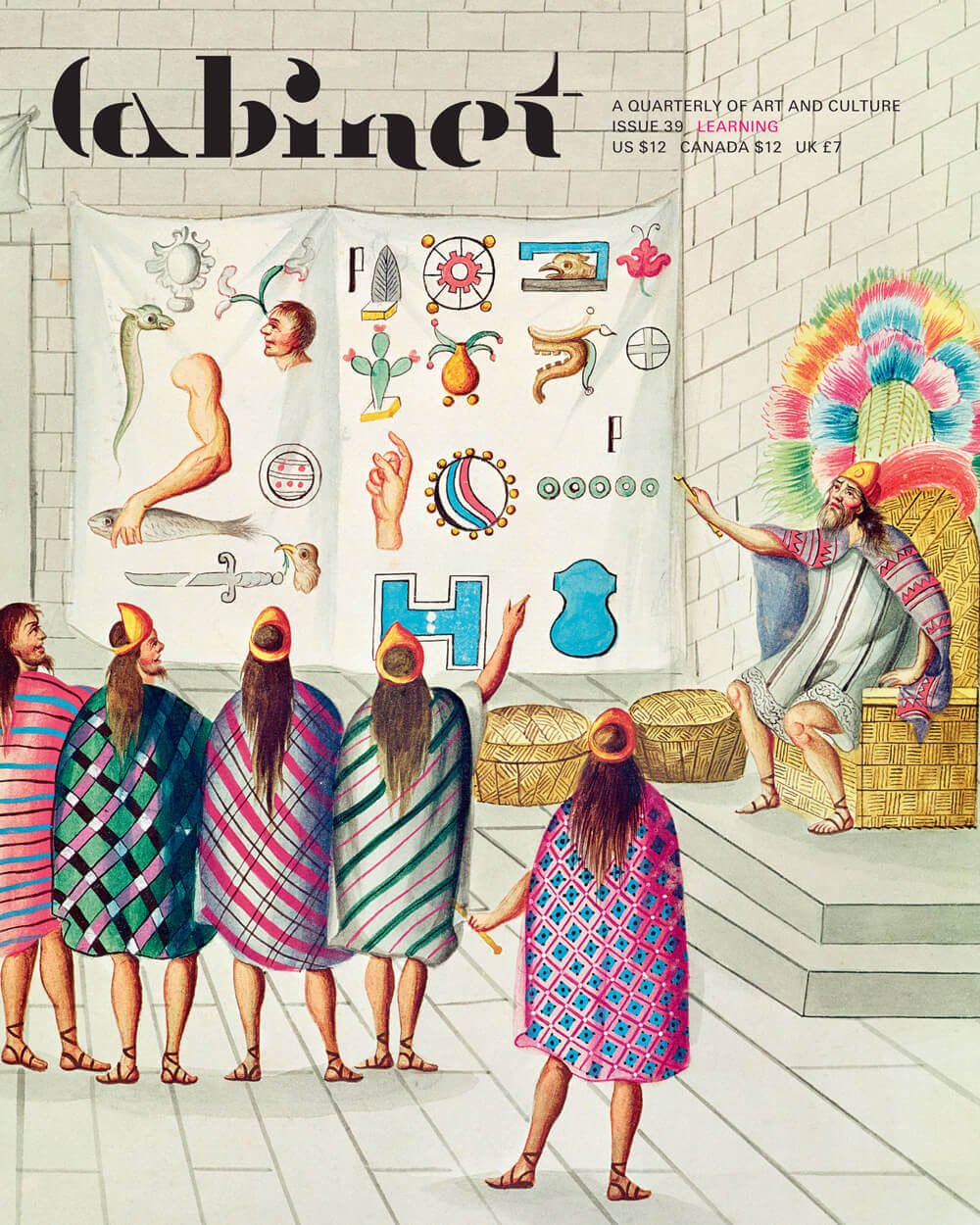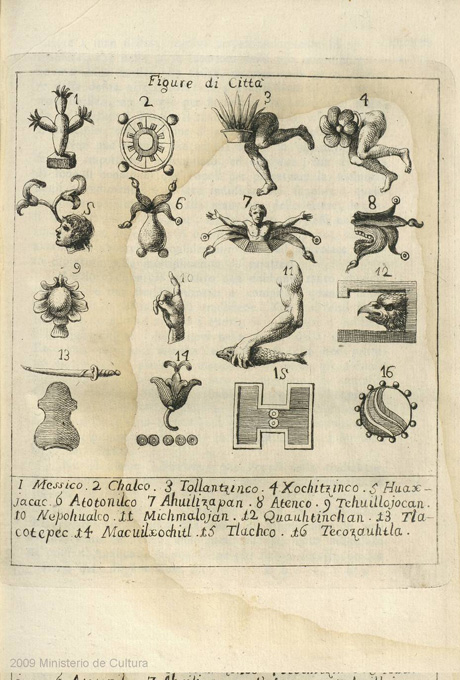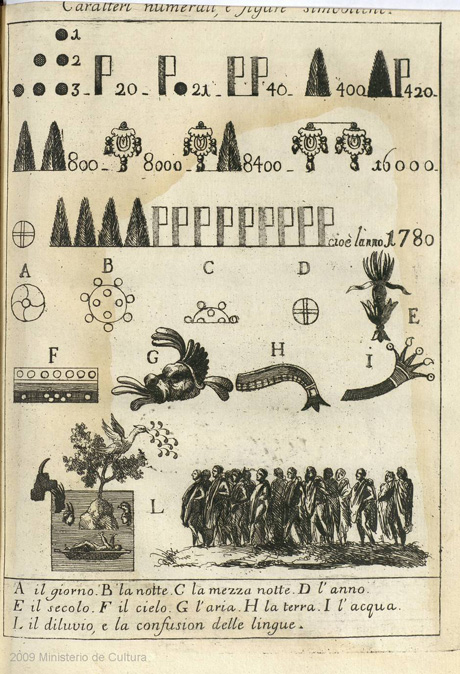Cover Story

The mystery of the Learning issue cover is now solved! For the background of this story, see here.
Jorge Canizares-Esguerra sent the following via the Cabinet magazine website:
This image indeed comes from Teatro by Diego Garcia Panes (1730–1811), produced in the 1770s–1790s. It is an eight-volume illustrated history of ancient Mexico based on the writings of Mariano Echeverria y Veytia (1718–1780). Some volumes have been published and are available in a good library.
The image is most likely a representation of the court of the Aztec lord Nezahualcoyotl, considered by Mexican historians as a great legislator. Nezayualcoyotl was seen as a misunderstood deist, particularly by Veytia, a scion from Puebla whose unpublished history of Mexico Panes transformed into an illustrated history, with captions that simply summarize sections of the book. The images on the textile in your cover image are representations of the Aztec system of writing. Most are images of logograms for towns; a few of the symbols represent numeric units. The figures in the scene might be representatives from vassal states paying tribute to Nezahualcoyotl, but it is more likely that they are his advisors looking at names of towns under Aztec control to inventory the resources at their disposal. It functions in some sense as a map of Aztec power.
All these symbols of place names and arithmetic units were published in a 1770 edition of the 1540s colonial codex "Matricula de Tributos." This edition was published by Francisco Antonio Lorenzana (1722–1804), archbishop of Nueva España, as an appendix to his Historia de Nueva España (see plates following page 177 in the online facsimile of the book at books.google.com/books?id=RUJ_0feZDY4C&dq=inauthor%3Alorenzana&pg=PP7#v=onepage&q&f=falsea).
Panes, however, did not consult Lorenzana’s volume, but found these symbols indirectly via the Mexican Jesuit scholar Francisco Clavijero’s ancient history of Mexico, published in Cesena, Italy, in two volumes in 1780 and 1781. Clavijero (1731–1787) produced his book in the papal states while in exile with his Jesuit brethren, who had all been expelled from Spanish colonies. Clavijero had access to Lorenzana’s recently published book, and Panes in turn copied Clavijero's interpretation of Lorenzana’s version of the original codex. I’ve attached two pages from Clavijero, from which Panes extracted many of the images to be found on the hanging textile.


For publications of Panes’s illustrations, see Diego García Panes, La conquista (selección de las laminas y textos de los tomos V y VI del Theatro de Nueva España), edited by José Ignacio Echeaganay and Ernesto de la Torre Villar (Mexico City: Celanese Mexicana/San Angel Ediciones, 1976) and Panorama de Anahuac (selección de láminas y textos de los tomos III y IV del Theatro de Nueva España), edited by José Ignacio Echeaganay and Ernesto de la Torre Villar (Mexico City: Celanese Mexicana/San Angel Ediciones, 1975).
For the antiquarian culture that produced your cover image and hundreds of other images by Panes, see my How to Write the History of the New World: Histories, Epistemologies, Identities in the Eighteenth-century Atlantic World (Stanford University Press, 2001).
Yours sincerely,
Jorge Canizares-Esguerra
Alice Drysdale Sheffield Professor of History
University of Texas-Austin
The story as of distribution of the Learning issue in November 2010.
Settling on the cover for a given issue of Cabinet is typically one of the very last decisions we make before we go to press. Though various possibilities are collected throughout the editorial process, it’s usually not until the entire magazine is laid out that the editors and the designer turn to the question of the cover in earnest, trying to balance issues of pertinence with what for lack of a better term might be called newsstand appeal.
As regular readers will know, over the years the cover has featured a range of sometimes rather obscure images and artifacts—from artistic, historical, scientific, and news sources—and, like many publications, Cabinet often turns to commercial image libraries for high-resolution photographs and reliable contextual information. This was the case with the colorful cover of the Learning issue, which we sourced from the Bridgeman Art Library, a central archive that manages material from more than two thousand fine art and historical collections around the world.
The image was captioned as:
Tome 3 f.118 Teaching the Reading of Manuscripts, from “Teatro de la Nueva Espana,” 1640 (w/c on paper) by Panes (fl.1640). Biblioteca Nacional de Mexico, Mexico.
Despite the apparent clarity of this information, we have learned over time that even settled captions like this need to be confirmed through additional independent research, but as our deadline grew near, we were unable to find any evidence that substantiated it. Growing increasingly suspicious of the work’s provenance, we contacted our colleague James Oles, a scholar of Latin American art at Wellesley College, who was able to identify some of the images on the curtain to which the chief figure is gesturing—including Aztec numerals and references to a ball game—but who also pointed out certain anachronisms—for example, the textile patterns in the cloaks worn by the figures in the image were not created until the eighteenth century—that made the date provided for the work impossible.
Meanwhile, an email exchange (in Spanish) initiated by Cabinet assistant editor Joshua Bauchner with an archivist at the Mexican National Library at least began to shed some light. The archivist confirmed that the illustration was from a manuscript called Teatro de Nueva España en su gentilismo y conquista, a pictorial history of pre-conquest Mexico written by Diego Garcia Panes y Avellán, a Spanish military officer. “Panes,” however, was not born until 1730, ninety years after the purported date of the image, and did not travel to Mexico until 1755. Teatro de Nueva España was unpublished but consisted of eight volumes, seven of which survive at the Biblioteca Nacional, and the archivist was able to locate them for us. In fact, the very page that we intended to publish had an extended caption; however, the textual information included there seemed to refer not to our image but to the other two in the folio sequence, speaking of women grinding, weaving, and performing other domestic activities. As if to add a slight tang of paranoia to the enterprise, the same archivist who was assisting us with our inquiries abruptly left the library a few days after beginning to help us with our research, and all further attempts to definitively identify the image proved fruitless.
Faced with an image that, at least superficially, seemed to depict a pedagogical moment—as well as one that clearly passed the newsstand appeal test—we decided to go ahead and put the image on the cover, hoping that we might be able to resolve the informational questions between the time we went to press and the time the magazine was distributed. Despite further research, we have unfortunately been unable to discover any additional information about it, and as Oles wrote in an email, it’s entirely possible that “no one in the world knows” for sure.
Call it a learning experience.
Spotted an error? Email us at corrections at cabinetmagazine dot org.
If you’ve enjoyed the free articles that we offer on our site, please consider subscribing to our nonprofit magazine. You get twelve online issues and unlimited access to all our archives.